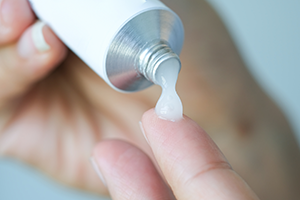Sign up to be notified of our new blog posts.
Limitations of Conventional Mixing Systems in Pharmaceutical Topical and Transdermal Drug Product Applications
Posted on May 15, 2019

Summary:
The inherent nature of high-viscosity pharmaceutical drug products poses real operational challenges to manufacturers. To succeed, processors must seamlessly combine safe and precise ingredient loading, powerful and durable blending, and sterile and efficient cleaning within their operation. Some manufacturers have found it difficult to solve these challenges due to limitations of conventional mixing systems.
Here are some of the most common issues with conventional mixing systems in pharmaceutical and other high-viscosity product settings.
Separate Dual-Mixer Systems Often Deliver Inefficient Results
Many high-viscosity products require two kinds of mixing action. Manufacturers sometimes attempt to achieve this mixing action by using slower-moving scrape surface agitation and a separate top-entry, high-shear mixer.
But this dual-mixer approach has major limitations:
- The configuration reduces the number of mixing bars, resulting in limited agitation
- It often leads to longer mixing times
- Pockets of unmixed ingredients may remain throughout the vessel
However, this two-stage process creates new problems:
- Increased processing time due to the transfer of product between vessels
- Additional equipment (transfer lines, pumps, etc.) required
- More complex cleaning procedures
- Regulatory hurdles with the FDA, since multiple vessels and product transfers may require separate compliance approvals
Though it could conceivably handle more product, this two-stage process is inherently inefficient. It requires additional processing time to move product from one vessel to another in addition to the transfer lines and pumps necessary to make the transfer in addition to complicating the cleaning requirements. FDA regulations can also complicate a two-vessel mixing operation. Use of multiple vessels and product transfer steps may require additional regulatory approval to keep the process fully compliant.
Recirculating High-Shear Systems: Powerful but Costly and Hard to Clean
Recirculating high-shear mixing systems can present an intriguing alternative to multi-vessel solutions. These high-performance systems constantly recirculate the product through a high-speed mixing apparatus and can mix products to sub-micron consistencies.
However, recirculating shear systems require additional external components and a product transfer recirculation loop, which are limited to lower viscosities and can potentially complicate clean-in-place (CIP) requirements. Typically, they are also more expensive than vessel-based mixing systems.
Recirculating high-shear mixing systems can blend products to sub-micron consistencies, making them an attractive alternative. These systems constantly move product through a high-speed mixing loop for intensive shear action.
Drawbacks include:
- Need for additional external components and transfer lines
- Limitations to lower-viscosity applications only
- Difficulties with CIP (Clean-in-Place)
- Higher cost compared to vessel-based systems
Bottom-Entry Shear Mixers Reduce Heat Transfer Efficiency
A final conventional solution to the challenges of high-viscosity product mixing is the bottom-entry shear mixing system. These mixing systems introduce the shear mixer at the lowest point in the vessel, optimizing batch potential.
However, the penetration of the mixer in the bottom of the vessel eliminates heat transfer surface area in a portion of the vessel. This setup also requires clearance from other agitation, limiting its ability to fully scrape the vessel. Limited scraped-surface agitation can impact heat transfer, in turn leading to potential unmixed and uneven heating/cooling of product on the jacketed vessel walls.
Bottom-entry shear systems place the mixer at the vessel’s lowest point, maximizing contact with product. But this comes at a cost:
- The mixer’s penetration reduces heat transfer surface area in the vessel bottom
- Required clearance from other agitation systems limits scraping effectiveness
- Inadequate scraped-surface agitation can result in uneven heating or cooling
- Poor heat transfer may leave unmixed or thermally inconsistent product on the jacketed vessel walls
How Lee meets the challenges of high-viscosity mixing
The Lee Tri-Mix Turbo-Shear: One System, Complete Solution
The issues with conventional dual-agitation vessels, multi-vessel mixing systems and complex single-unit systems like recirculating- and bottom-shear mixers still leave the industry searching for a solution. The unique design of the Lee Industries Tri-Mix Turbo-Shear mixing system addresses all these drawbacks, handling high-viscosity products in a single customized configuration to meet a wide variety of process requirements.
Key advantages:
- Integrates powerful dual-motion agitation and high-shear capabilities in one vessel
- Streamlines mixing and cleaning
- Eliminates the need for additional vessels, pumps, or transfer lines
- Supports compliance with stringent pharmaceutical regulations
Conventional Mixers Have Limits, Lee's Tri-Mix System Solves Them
Whether you're formulating topical ointments, transdermal gels, or complex lotions, conventional mixing setups often create more problems than they solve. Lee Industries' Tri-Mix Turbo-Shear offers a custom-engineered, compliant, and efficient solution for modern pharmaceutical manufacturing challenges.
Last Updated: 10/17/2025
Comments
Add Your Own Comment